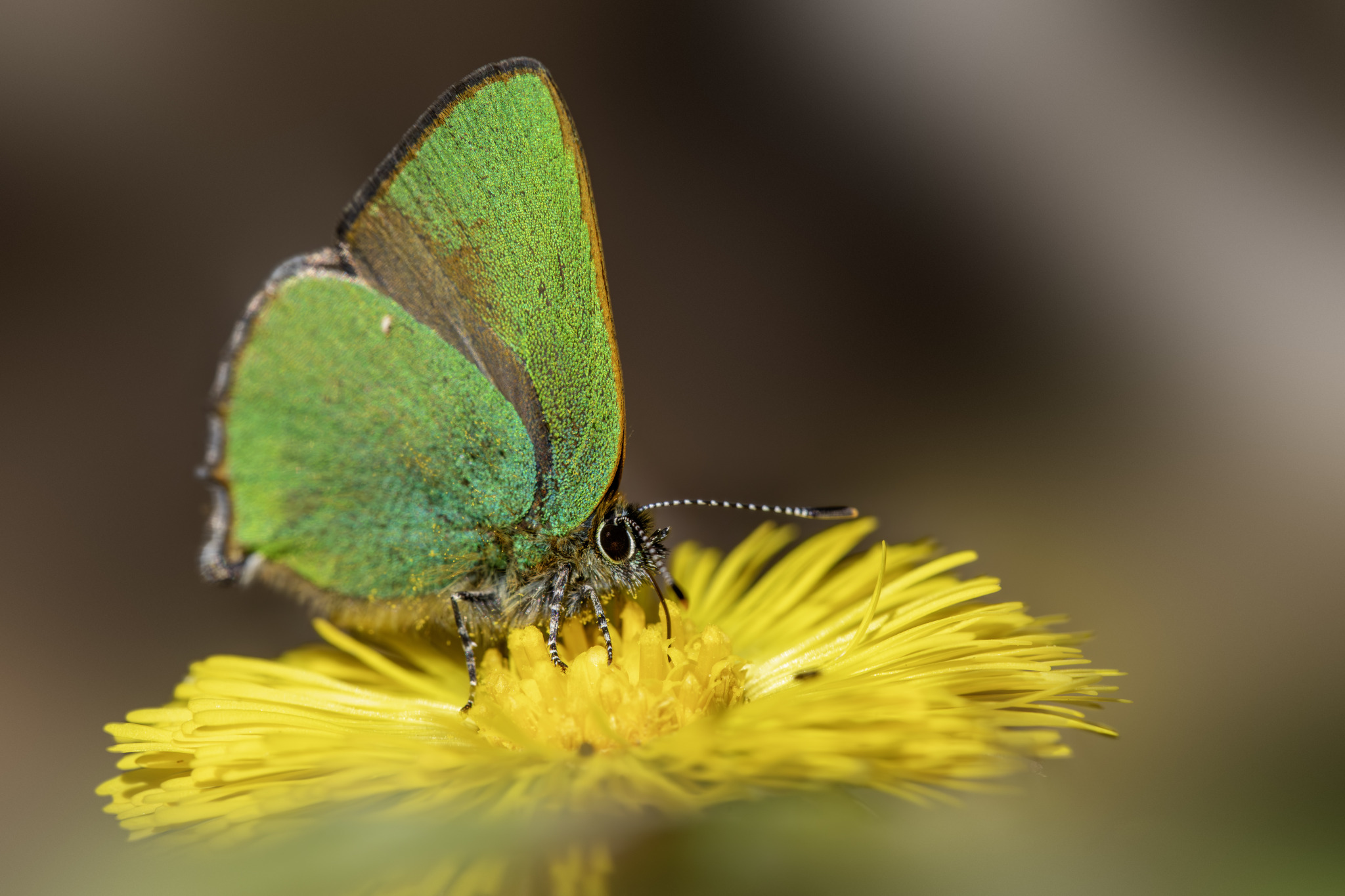Deep Overview: Green Hairstreak (Callophrys rubi)
The Green Hairstreak (Callophrys rubi) is a small but striking butterfly found across Europe, Asia, and North Africa. It is easily recognized by its vivid green underwings, which provide excellent camouflage against foliage. Despite its wide distribution, this species remains elusive due to its secretive nature and preference for scrubby habitats.
Taxonomy & Classification
- Kingdom: Animalia
- Phylum: Arthropoda
- Class: Insecta
- Order: Lepidoptera
- Family: Lycaenidae (Blues, Coppers, and Hairstreaks)
- Genus: Callophrys
- Species: Callophrys rubi
- Common Names:
- Green Hairstreak
- Green Blue (informally, though not a true blue butterfly)
Physical Description
- Wingspan: 25–30 mm (1.0–1.2 in)
- Coloration & Markings:
- Upperwings: Dark brown (rarely visible when resting)
- Underwings: Bright, iridescent green with a faint white streak (sometimes absent)
- Body: Covered in fine hairs, giving a slightly fuzzy appearance
- Antennae: Black and white banded, clubbed at the tip
- Key Features:
- Unlike many hairstreaks, it lacks the “tail” extensions on its hindwings
- Males and females look similar, though females tend to be slightly larger
Distribution & Habitat
- Geographic Range:
- Widespread across Europe, North Africa, and temperate Asia
- Found from Britain and Scandinavia to Japan and the Middle East
- Preferred Habitat:
- Heathlands, scrublands, woodland clearings, grasslands, and coastal dunes
- Prefers warm, dry, and open areas with plenty of sunlight
- Frequently seen on gorse, brambles, and other shrubs
Behavior & Adaptations
- Territorial Males:
- Males perch on shrubs and bushes, defending their territory against rivals
- Excellent Camouflage:
- The green underwings blend seamlessly with leaves, making it hard to spot
- Weak Flyer but Agile:
- Stays close to the ground, making short, darting flights
- Sun-Loving Butterfly:
- Basks in the sun but always rests with its wings closed, showing only the green side
Diet & Feeding Habits
- Caterpillars (Larvae):
- Feed on various plants, including gorse, bilberry, bramble, broom, and bird’s-foot trefoil
- Adult Butterflies:
- Nectar feeders, preferring flowers like dandelions, buttercups, and heather
- Often found sipping from gorse and hawthorn blossoms
Reproduction & Life Cycle
- Breeding Season:
- Spring to early summer (April–July, depending on location)
- Egg-Laying:
- Females lay single eggs on host plants, often on flower buds
- Caterpillar Stage:
- Small, green, and well-camouflaged
- Resembles a tiny, segmented slug
- Pupation & Overwintering:
- Chrysalis forms in leaf litter or soil
- Overwinters as a pupa, emerging in spring
- Lifespan:
- Adults live only a few weeks
Predators & Threats
- Natural Predators:
- Birds, spiders, and predatory insects
- Human-Related Threats:
- Habitat loss due to agriculture and urbanization
- Climate change affecting plant cycles
- Overgrazing in heathland areas reduces host plants
- Conservation Status:
- Listed as Least Concern (LC), but declining in some regions
Ecological Importance
- Pollinator:
- Helps pollinate wildflowers and shrubs
- Part of the Food Chain:
- Caterpillars provide food for birds and predatory insects
Relationship with Humans
- Sought-After by Butterfly Enthusiasts:
- Hard to spot, but rewarding for those who find it
- Indicator of Healthy Ecosystems:
- Presence suggests a diverse, unspoiled habitat
- No Agricultural Impact:
- Unlike some butterfly species, it does not harm crops
Fun Facts
- Green color is an optical illusion—caused by light reflecting off tiny scales!
- Males defend their territory aggressively, even chasing away larger insects
- Unlike many butterflies, it rarely opens its wings when resting
- Can survive in various habitats, from coastal cliffs to mountain slopes
Conclusion
The Callophrys rubi is a beautiful yet elusive butterfly that thrives in sunny, shrubby habitats. Its green camouflage, territorial behavior, and adaptability make it a fascinating species. Although it remains relatively common, habitat destruction threatens its populations in some areas.
Visited 45 times, 1 visit(s) today
Views: 391
Subscribe to the newsletter:
